How to choose a simracing rig
Choosing a simracing rig is a very big step in the life of a virtual driver. Very often, our cockpit will follow us for years and years in the race. On top of that, it’s one of the most expensive pieces of simracing equipment to buy. So you need to make sure you make the RIGHT choice, so you have no regrets and, above all, maximum pleasure!
Today, I’d like to take you through the questions I STRONGLY advise you to ask yourself BEFORE you buy. Obviously, you’re free to follow this advice or not… If you don’t want to answer these questions, you can jump straight to my list of the best simracing cockpits. Just click on the section you’re interested in in the table of contents below 😉
Questions to ask yourself before buying a simracing rig
Honestly, though, taking the time to ask yourself the few questions I’ve listed here is the best way to avoid making a mistake you’ll regret. Well, that’s that! Let’s get on with it 🙂
How much space have you planned for your simracing rig?
It may sound silly when you put it like that, but cockpits are often bigger than they look in photos. So it’s imperative that you know in advance how much space you can really devote to your passion.
If you’re lucky enough to have a room dedicated to your passion for racing, great! But if, like me, you only have room in the living room, that’s another story. I therefore invite you to take measurements of the space available. Don’t forget that this space must be in the direct vicinity of electrical outlets if you don’t want to end up with extension cords all over the place!
What’s more, the amount of space you have will determine a lot of things later on. If you don’t have enough space for a fixed rig, you’ll have to go for a folding cockpit, which means compromising on certain technical aspects (more on this later).
On top of that, having room for a fixed rig is all well and good, but if your dream is to have 3 screens, then count on double the width!
In short, you heard me right: MEASURE the ACTUAL space available. If you don’t, you’ll either be disappointed, or you’ll be burned by your family because no one has access to the living room table anymore… (yes, I’ve been there ^^)
So, where do you fit in? Don’t just nod and smile! Measure and note. Come on! 😉
What’s the budget for your simracing cockpit?
OK, you’ve measured the available space, and if need be, you’ve negotiated with your other half to free up that useless coffee table next to Aunt Marie’s pedestal table… That’s all well and good, but now it’s time to talk money.
What budget can you devote to this project? 300, 500, 700, 1000€, more? Depending on the answer to this question, you won’t have access to the same services. In fact, there’s something for everyone. I’ll talk about budget cockpit solutions later in the article, but you really need to think about your budget beforehand. Otherwise, you may be very surprised or disappointed 😉
So, what’s a realistic budget for this project?
What’s really important to you in simracing?
Having a budget is all well and good… But really, why do you want to bother with a simracing rig? Is it to enjoy yourself and relax for an hour or two a week? Or are you already hooked on the world of virtual tracks and want a real cockpit to take you to the next level? Maybe you want to train for ESports competitions? Maybe even endurance racing?
As you’d expect, depending on your answer here too, the cockpits won’t be the same at all. You won’t have the same requirements when you just want to relax on Gran Turismo 7 for two or three hours a week, or when you’re preparing for an ESports endurance championship.
Since your use will define your requirements, you need to know what you want from simracing today. So, you’ve written down your expectations? Then we can move on to the next step.
What simracing equipment are you going to install?
Now you know what you want from simracing, but that’s not all. Now we need to talk about the hardware you want to install on it.
If you’re running low-power bases like Logitech, Thrustmaster or Fanatec’s belt-driven models, then you don’t have much to worry about.
On the other hand, if you’re on Direct Drive, for example with the Fanatec CSL DD / GT DD Pro, the Moza R9, or the Simagic Alpha Mini, not all rig will be suitable. And if you have more powerful Direct Drive bases, the choices narrow down even further.
And why? Because to take the force of a Direct Drive, your cockpit will need to be stiffer, more resistant. This often (but not always) means more expensive too.
The same applies to the accessories you plan to install. Do you have a shifter ? Or a handbrake? If so, you’ll need to take this into account, as not all cockpits offer solutions for installing them directly.
How will you optimize your simracing rig over time?
Simracing is often first and foremost a passion. And you know how passions are… You start off with a cheap little steering wheel, get hooked and in a few months or years you end up with the equivalent of an F1 team in your living room.
One thing I’ve noticed among my simracing friends is that, without exception, they all end up drastically upgrading their equipment over time. So, even if you tell yourself today that a simple, no-frills fixed rig will do, in a few months’ time I bet you’ll be looking for ways to improve it.
Often it’ll start with an arm to fit your shifter orhandbrake. And then a few more months go by and you’re thinking that a keyboard support would be really handy… Oh, and then two years later, you really want to buy some jacks!
Anyway, the point is. Your equipment is going to evolve, so get a rig that can evolve with you and your desires. Sometimes it’s tempting to save a few dozen euros for a less progressive model. But you know what? That’s a huge mistake. Because the day you want to upgrade your equipment, you’ll have to sell your rig and start your search all over again..
Oh yes, by the way, selling a rig is a pain. Nobody wants to pay the exorbitant shipping costs, so you’re limited to trying to sell it around your home… No, frankly, save yourself the trouble and go straight for a model that’s capable of keeping up with you for years to come.
And for those who think they’ll never want to upgrade, that cylinders are too expensive and triple screens are useless… Remember that just a few months ago, a Direct Drive cost a minimum of a minimum wage, but everything evolves and technology always comes down in the end.
By the way, how big are you?
That’s a size factor, if I dare say it. Before you start drooling over this or that cockpit model, you need to know whether it’s going to fit you. If you’re thinking of buying a fixed or dynamic simracing rig, having the right size bucket seat is a must. It’s all about your comfort, and ultimately, your enjoyment of the game.
Most brands offer different sizes of bucket seats. But your morphology isn’t the only thing to consider. You also need to think about your size. For example, the Trak Racer TR8 I have at home fits me perfectly (I’m 1.74m). However, it doesn’t fit Flo, who’s just under 1.60m tall. Even with the seat as far forward as possible, she has trouble pushing the pedals all the way (especially the brake). Let’s face it, this is very problematic when racing!
The different types of support
Now that all these questions have been answered, we can start talking about the cockpits on the market. There are 3 main types of simracing rig.
- Foldable rig: these take up very little space and can be stored in a cupboard when not in use. A good choice for occasional players or those with very little space available.
- Fixed rig: these are bulkier and require dedicated space. They are much more rigid than folding cockpits, and can accommodate more powerful flywheels. Most of the time, they’re highly upgradeable, but be sure to check that before you pull out your credit card.
- Dynamic rig: these are jack-mounted, so if this is your first purchase, forget it. These models cost the price of a small new car. You’ll think about dynamic rig when you’ve already got a lot of virtual kilometers on the odometer and you’re sure that’s what you want.
What to look out for when choosing a simracing rig?
I’d like to take this opportunity to give you a few points to bear in mind when choosing a model. Sometimes you can find a cockpit that looks great on paper, that fits all your criteria, but end up disappointed with your choice. The fault lies in the parameters you didn’t take into account.
So what to look out for? Well, the first thing is: the fewer the parts, the better. In other words, when you compare simracing rig, go for the models requiring the fewest assembly points.
Why should you do this? Because every assembly point, every connection between parts, is a potential bending point. On a cockpit, you need rigidity. The stiffer the rig, the more we’ll be able to feel every little detail of the steering wheel’s force feedback.
On top of that, long-term flexibility means more wear and tear on parts and a shorter lifespan. Do we understand each other? The fewer parts the better.
And the second point we sometimes forget is seat comfort. Don’t make the same mistake as I did in trying to save a few dozen euros on the bucket seat… In practice, it ends up hurting your back after a few hours. Good lumbar support will make all the difference, especially for owners of Load Cell cranksets. After hundreds of braking sessions, your lower back takes a beating if you don’t have an adapted seat.
GOOD! At last, we can move on to the models. Ahhh, I can hear you thinking very loudly, “It’s about damn time! I know, I’ve said a lot, but it’s for your own good and that of your wallet. So here are the models I’m currently recommending.
Next Level Racing Wheel Stand 2.0
Next Level Racing is one of the must-have names in the cockpit world. Their Wheel Stand 2.0 model is particularly interesting if you don’t have much space at home. It’s a well-designed folding stand that’s rigid enough for all the belt bases on the market.
- Type : Foldable
- Dimensions : Maximum 92.5cm long, 57.5cm wide and 78.5cm high
- Driving position: Rally / GT
- Comfort : Will depend on your office chair
- Adjustments: Height, base tilt, bottom bracket tilt and distance
- Materials: Steel
- Rigidity: 7/10
- Possible upgrades: Can be completely transformed into a complete cockpit, Next Level Racing has a very, very wide range of add-ons
- Price: from 229€ TTC
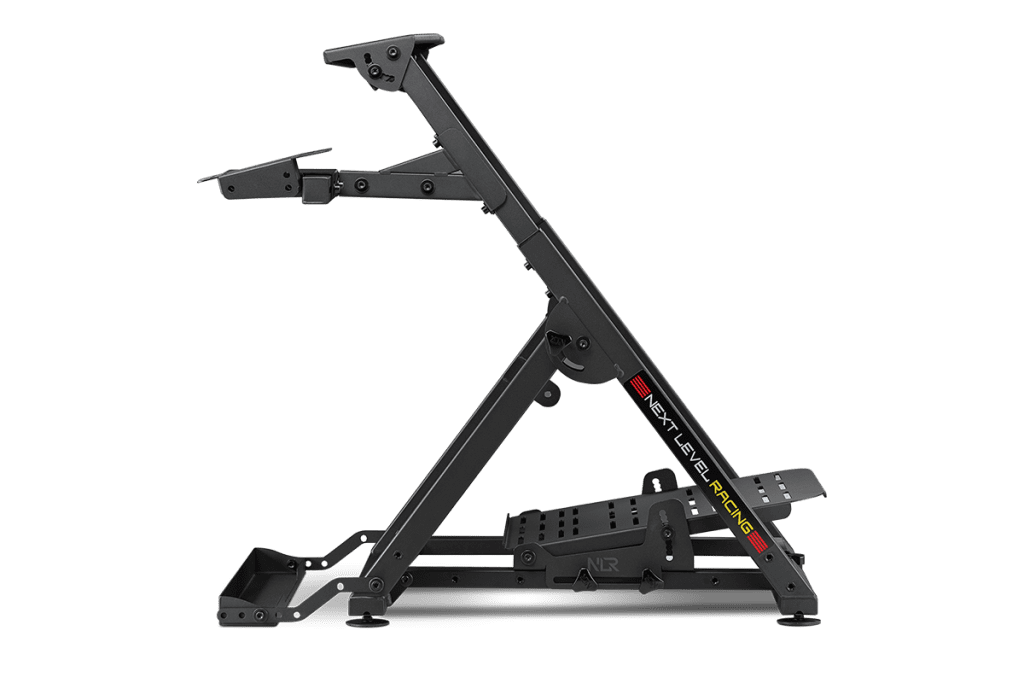
Cockpit RSeat P1
RSeat is a French brand that produces high-quality simracing cockpits. In fact, Barry Rowland of Sim Racing Garage called the P1 the stiffest prefabricated cockpit he’d ever tested. And that’s saying something!
- Type : Fixed
- Dimensions : Minimum without options 1.78m long by 0.60m wide (without options). Allow 1.10m maximum width with triple screen support
- Driver height: from 1.27m to 2m
- Driving position: Rally / GT
- Comfort : The rig can be delivered with Sparco or RSeat bucket seats. In both cases, quality is paramount!
- Adjustments: Seat and pedals on slides and tilt
- Rigidity: 10/10
- Possible upgrades: Arm for Shifter, handbrake, keyboard and mouse support, screen support, Buttkicker support, tablet and Button box support, mounting for Simucube base. Switching to a dynamic rig with a D-Box system.
- Price: from 769€ TTC
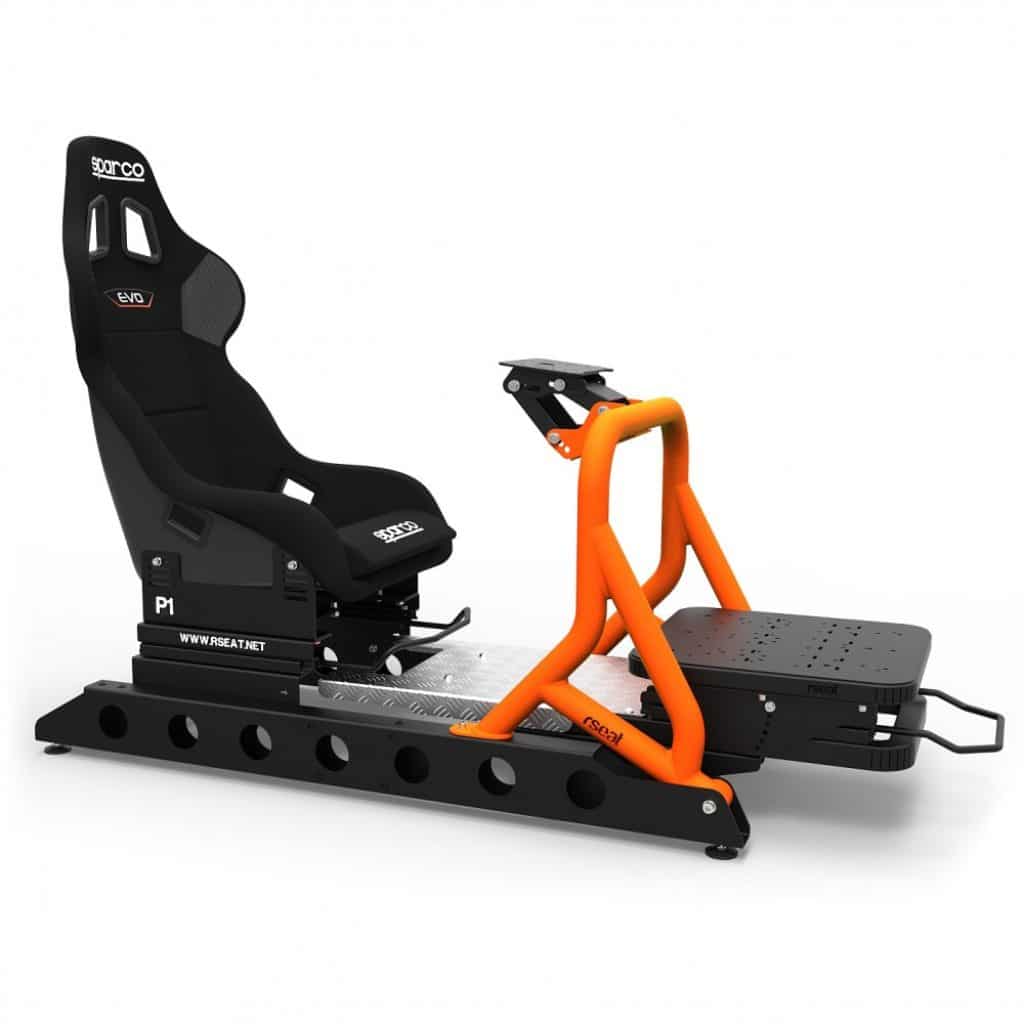
The Trak Racer TR8 Pro
The new TR8 Pro has arrived with a number of upgrades that make it far more attractive than the old TR8. More advanced tuning, improved rigidity and better value for money.
- Type : Fixed
- Dimensions : 100cm long by 70cm wide and 70cm high
- Driver height: from 1.55m to 2m
- Driving position: Rally / GT
- Comfort: The rig can be delivered with a Trak Racer bucket. Be careful, however, to choose a suitable model, think about your lower back! You can also install any other tub on the market.
- Adjustments: Seat and pedals on slides, tilt. depth and inclination of the steering wheel base.
- Materials: Steel
- Rigidity: 9/10
- Possible upgrades: Screen support, Buttkicker support, handbrake and shifter support, casters, speaker support.
- Price: from 659€ TTC
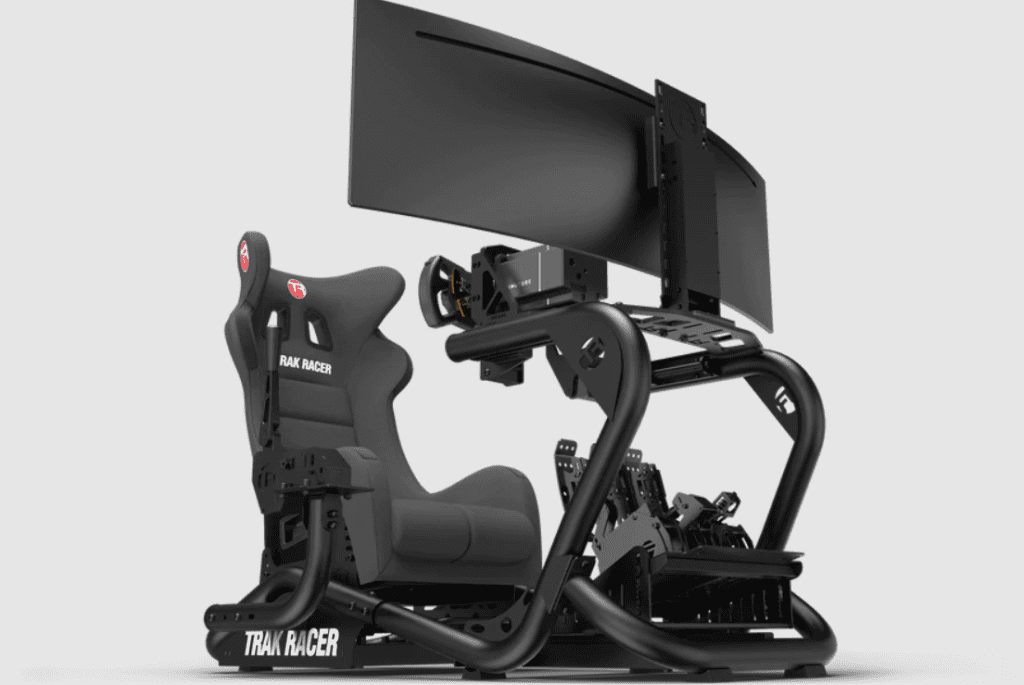
Playseat F1 Intelligence
I have to admit that we’re moving into a category that’s less accessible to the wallet. But when you love it, you don’t count, right? The Playseat F1 Intelligence is one of the brand’s top-of-the-range models, and can even be found in Charles Leclerc’s Monaco apartment.
- Type: Fixed
- Dimensions: 168cm long, 61.5cm wide and 73.5cm high
- Driver height: from 1.60m to 1.85m
- Driving position: Formula
- Comfort: The seat offers perfect support
- Adjustments: Seat, bottom bracket tilt and distance, steering wheel base tilt.
- Materials: Steel
- Rigidity: 10/10
- Possible upgrades: Ground sheet
- Price: from 2.499€ TTC
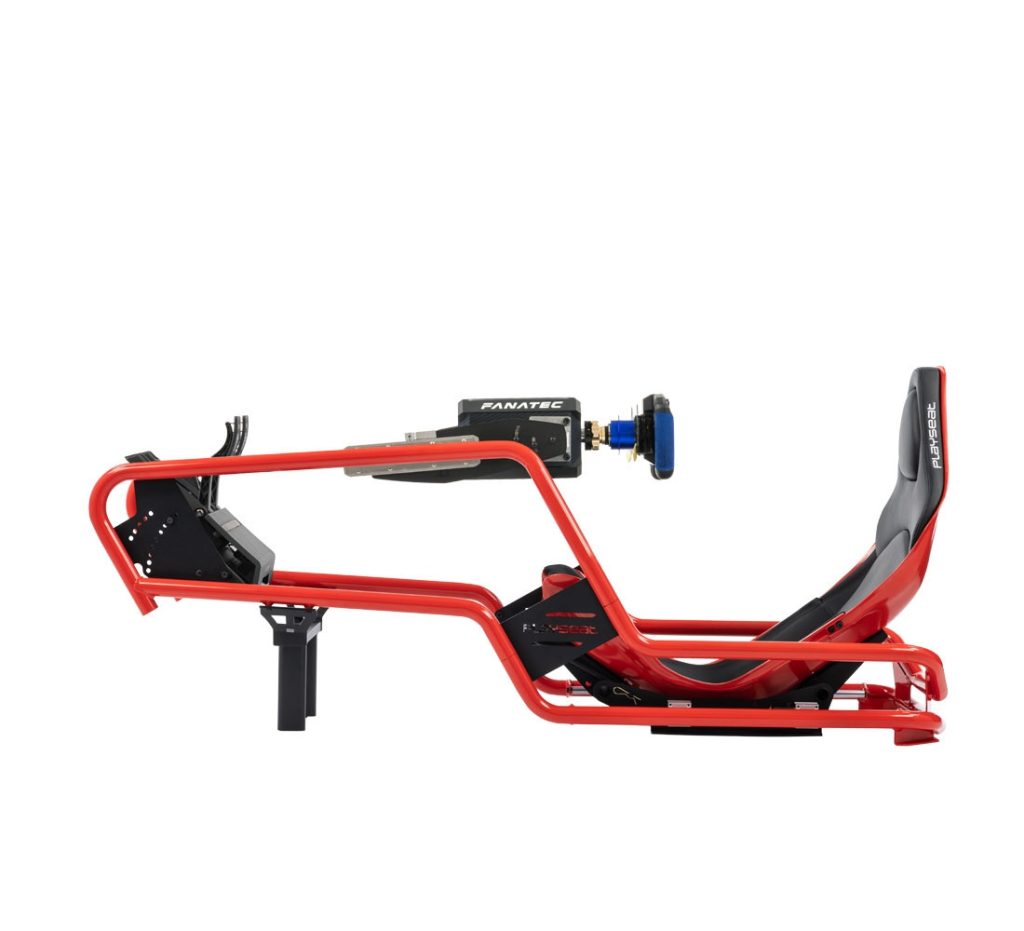
RSeat G1 1500
RSeat has created the G1 range of dynamic rig in partnership with D-Box (creators of haptic systems). Obviously, this is not the type of system a beginner should be aiming for. But if you’re a simracing enthusiast and want to push your sensations even further, then it’s definitely worth a look.
- Type: Dynamic
- Dimensions: 200cm long, 100cm wide and 100cm high.
- Driver height: from 1.27m to 2m
- Driving position: Rally / GT
- Comfort: The rig can be delivered with Sparco or RSeat seats. In both cases, quality is paramount!
- Adjustments: Seat and pedals on sliders. Seat and pedal tilt. D-Box haptic system.
- Materials: Steel
- Rigidity: 10/10
- Possible upgrades: Arm for Shifter, handbrake, keyboard and mouse support, screen support, Buttkicker support, tablet and Button box support, mounting for Simucube base.
- Price: from 11.998,80€ TTC
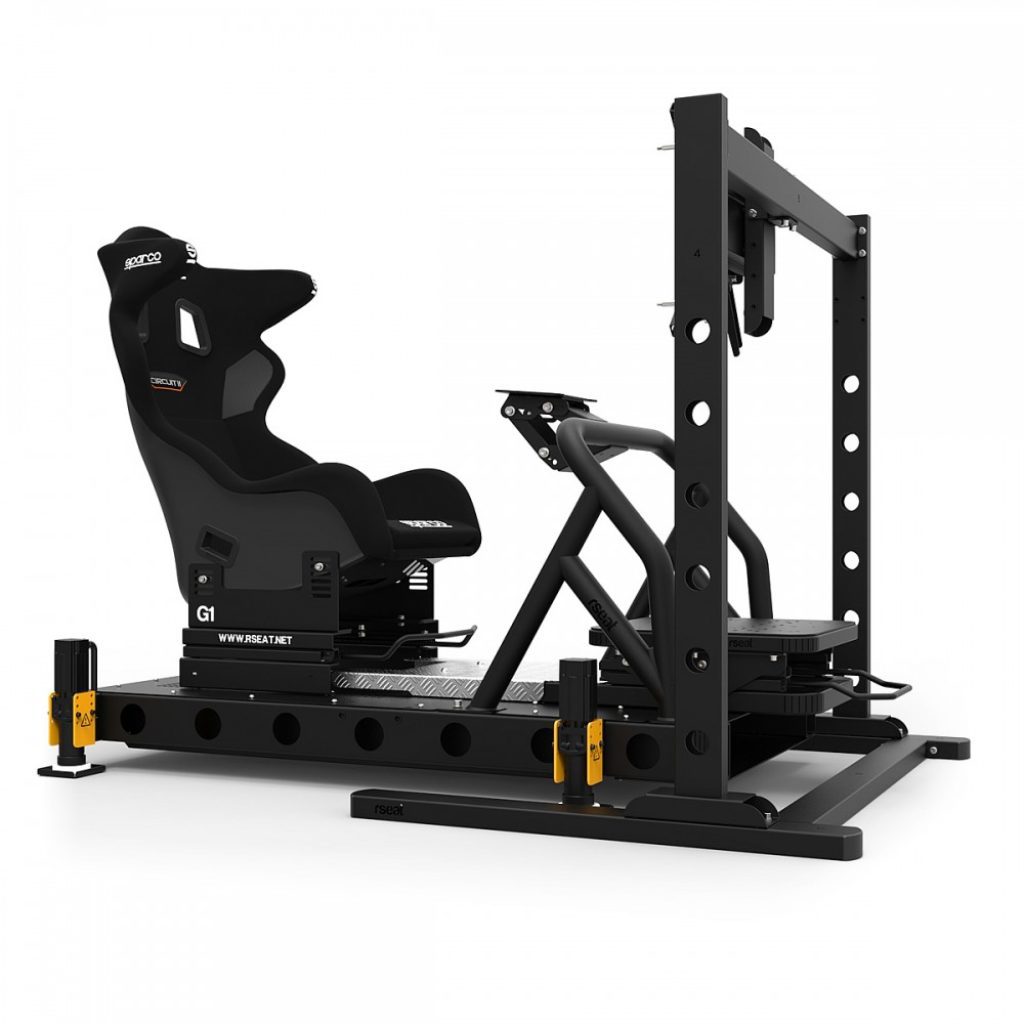
So, do you know which model to go for?
Well, I sincerely hope that this guide to choosing a simracing rig has enlightened and helped you. Choosing a cockpit is something that needs to be thought through, because you’re generally going to keep this structure for many years.
If you like this guide, don’t hesitate to share it with your simracing friends. Maybe they too will find answers to their questions thanks to you 🙂
